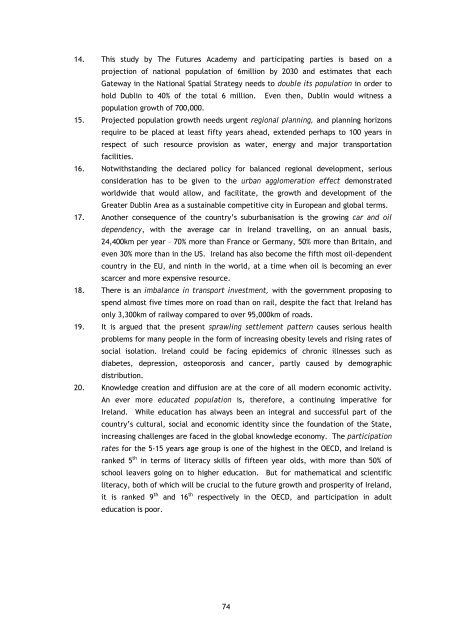TWICE THE SIZE - DIT Update - Dublin Institute of Technology
TWICE THE SIZE - DIT Update - Dublin Institute of Technology
TWICE THE SIZE - DIT Update - Dublin Institute of Technology
Create successful ePaper yourself
Turn your PDF publications into a flip-book with our unique Google optimized e-Paper software.
14. This study by The Futures Academy and participating parties is based on a<br />
projection <strong>of</strong> national population <strong>of</strong> 6million by 2030 and estimates that each<br />
Gateway in the National Spatial Strategy needs to double its population in order to<br />
hold <strong>Dublin</strong> to 40% <strong>of</strong> the total 6 million. Even then, <strong>Dublin</strong> would witness a<br />
population growth <strong>of</strong> 700,000.<br />
15. Projected population growth needs urgent regional planning, and planning horizons<br />
require to be placed at least fifty years ahead, extended perhaps to 100 years in<br />
respect <strong>of</strong> such resource provision as water, energy and major transportation<br />
facilities.<br />
16. Notwithstanding the declared policy for balanced regional development, serious<br />
consideration has to be given to the urban agglomeration effect demonstrated<br />
worldwide that would allow, and facilitate, the growth and development <strong>of</strong> the<br />
Greater <strong>Dublin</strong> Area as a sustainable competitive city in European and global terms.<br />
17. Another consequence <strong>of</strong> the country’s suburbanisation is the growing car and oil<br />
dependency, with the average car in Ireland travelling, on an annual basis,<br />
24,400km per year – 70% more than France or Germany, 50% more than Britain, and<br />
even 30% more than in the US. Ireland has also become the fifth most oil-dependent<br />
country in the EU, and ninth in the world, at a time when oil is becoming an ever<br />
scarcer and more expensive resource.<br />
18. There is an imbalance in transport investment, with the government proposing to<br />
spend almost five times more on road than on rail, despite the fact that Ireland has<br />
only 3,300km <strong>of</strong> railway compared to over 95,000km <strong>of</strong> roads.<br />
19. It is argued that the present sprawling settlement pattern causes serious health<br />
problems for many people in the form <strong>of</strong> increasing obesity levels and rising rates <strong>of</strong><br />
social isolation. Ireland could be facing epidemics <strong>of</strong> chronic illnesses such as<br />
diabetes, depression, osteoporosis and cancer, partly caused by demographic<br />
distribution.<br />
20. Knowledge creation and diffusion are at the core <strong>of</strong> all modern economic activity.<br />
An ever more educated population is, therefore, a continuing imperative for<br />
Ireland. While education has always been an integral and successful part <strong>of</strong> the<br />
country’s cultural, social and economic identity since the foundation <strong>of</strong> the State,<br />
increasing challenges are faced in the global knowledge economy. The participation<br />
rates for the 5-15 years age group is one <strong>of</strong> the highest in the OECD, and Ireland is<br />
ranked 5 th in terms <strong>of</strong> literacy skills <strong>of</strong> fifteen year olds, with more than 50% <strong>of</strong><br />
school leavers going on to higher education. But for mathematical and scientific<br />
literacy, both <strong>of</strong> which will be crucial to the future growth and prosperity <strong>of</strong> Ireland,<br />
it is ranked 9 th and 16 th respectively in the OECD, and participation in adult<br />
education is poor.<br />
74








